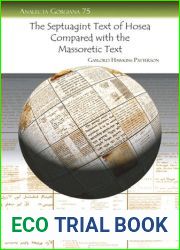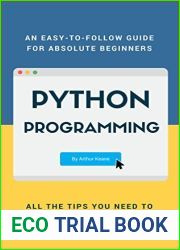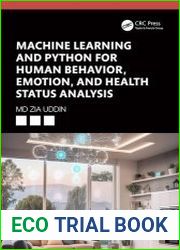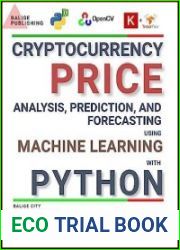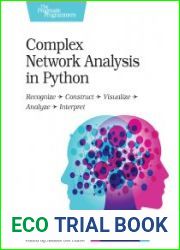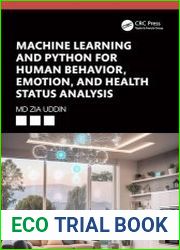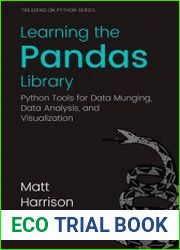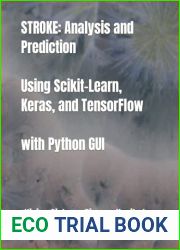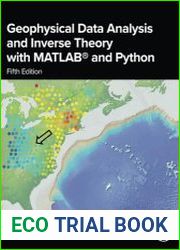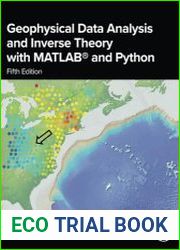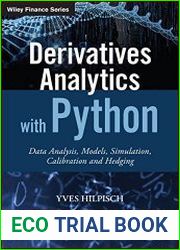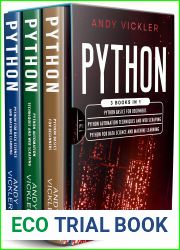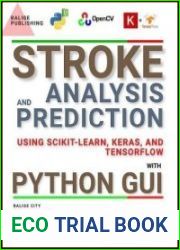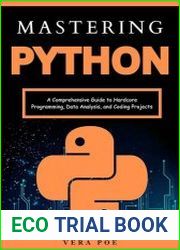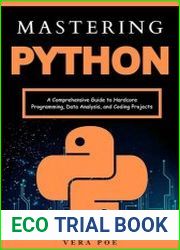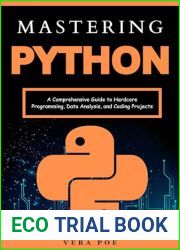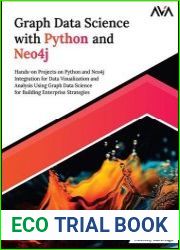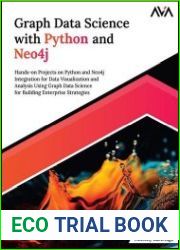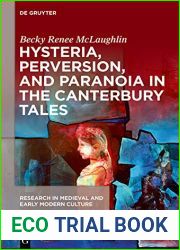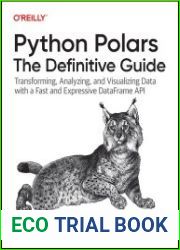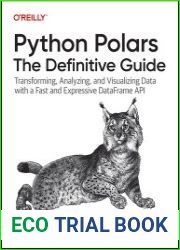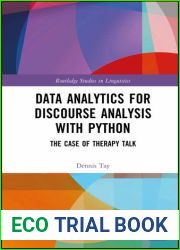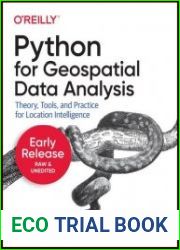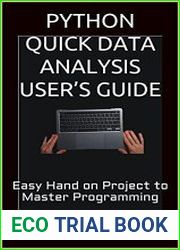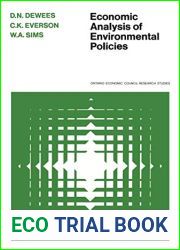
BOOKS - PROGRAMMING - Text Analysis with Python A Research Oriented Guide

Text Analysis with Python A Research Oriented Guide
Author: Mamta Mittal, Gopi Battineni, Bhimavarapu Usharani, Lalit Mohan Goyal
Year: 2022
Pages: 268
Format: PDF
File size: 28,2 MB
Language: ENG

Year: 2022
Pages: 268
Format: PDF
File size: 28,2 MB
Language: ENG

The first chapter introduces the concept of text analysis and its importance in research, while the second chapter covers the basics of natural language processing (NLP) and text preprocessing. The third chapter discusses the application of NLP techniques such as tokenization, stemming, lemmatization, and stop words removal. The fourth chapter explores the use of machine learning algorithms such as Naive Bayes, Logistic Regression, Decision Trees, Random Forest, and Support Vector Machines for text classification. The fifth chapter delves into the use of deep learning models such as Convolutional Neural Networks (CNN), Recurrent Neural Networks (RNN), Long Short-Term Memory (LSTM) networks for text classification. The sixth chapter focuses on sentiment analysis and opinion mining. The seventh chapter covers text clustering and topic modeling. The final chapter provides practical examples and case studies to reinforce the concepts learned throughout the book. The book is written in an easy-to-understand format and includes numerous code examples and exercises to help readers practice their skills. It also includes real-world examples and case studies to illustrate the applications of text analysis in various fields. The book is suitable for both beginners and advanced learners who want to explore the world of text analysis using Python programming language.
Первая глава вводит понятие анализа текста и его важность в исследованиях, в то время как вторая глава охватывает основы обработки естественного языка (NLP) и предварительной обработки текста. В третьей главе обсуждается применение техник NLP, таких как токенизация, стемминг, лемматизация и удаление стоп-слов. В четвертой главе рассматривается использование алгоритмов машинного обучения, таких как Naive Bayes, Logistic Regression, Decision Trees, Random Forest и Support Vector Machines для классификации текста. Пятая глава углубляется в использование моделей глубокого обучения, таких как сверточные нейронные сети (CNN), рекуррентные нейронные сети (RNN), сети длинной краткосрочной памяти (LSTM) для классификации текста. Шестая глава посвящена анализу настроений и анализу мнений. Седьмая глава охватывает кластеризацию текста и тематическое моделирование. В заключительной главе приводятся практические примеры и тематические исследования для закрепления концепций, усвоенных на протяжении всей книги. Книга написана в удобном для понимания формате и включает в себя многочисленные примеры кода и упражнения, помогающие читателям отработать свои навыки. Он также включает реальные примеры и тематические исследования для иллюстрации применения текстового анализа в различных областях. Книга подойдет как начинающим, так и продвинутым ученикам, которые хотят исследовать мир анализа текста с помощью языка программирования Python.
premier chapitre introduit la notion d'analyse du texte et son importance dans la recherche, tandis que le deuxième chapitre traite des bases du traitement du langage naturel (PNL) et du prétraitement du texte. troisième chapitre traite de l'application des techniques NLP telles que la tokenisation, le stemming, la lemmatisation et la suppression des mots stop. quatrième chapitre traite de l'utilisation d'algorithmes d'apprentissage automatique tels que Naive Bayes, Logistic Regression, Decision Trees, Random Forest et Support Vector Machines pour classer le texte. cinquième chapitre est consacré à l'utilisation de modèles d'apprentissage profond tels que les réseaux neuronaux convolutifs (CNN), les réseaux neuronaux récurrents (RNN), les réseaux à mémoire longue à court terme (LSTM) pour classer le texte. sixième chapitre est consacré à l'analyse des sentiments et des opinions. septième chapitre traite du regroupement de textes et de la modélisation thématique. dernier chapitre donne des exemples pratiques et des études de cas pour ancrer les concepts appris tout au long du livre. livre est écrit dans un format facile à comprendre et comprend de nombreux exemples de code et d'exercices pour aider les lecteurs à développer leurs compétences. Il comprend également des exemples concrets et des études de cas pour illustrer l'application de l'analyse textuelle dans différents domaines. livre conviendra aux élèves débutants et avancés qui veulent explorer le monde de l'analyse de texte avec le langage de programmation Python.
primer capítulo introduce el concepto de análisis del texto y su importancia en la investigación, mientras que el segundo capítulo abarca las bases del procesamiento del lenguaje natural (NLP) y el tratamiento previo del texto. En el tercer capítulo se discute la aplicación de técnicas de NLP como la tokenización, el estemming, la lemmatización y la eliminación de palabras stop. cuarto capítulo examina el uso de algoritmos de aprendizaje automático como Naive Bayes, Logistic Regression, Decision Trees, Random Forest y Support Vector Machines para clasificar el texto. quinto capítulo profundiza en el uso de modelos de aprendizaje profundo, como redes neuronales perforadas (CNN), redes neuronales recurrativas (RNN), redes de memoria larga a corto plazo (LSTM) para clasificar el texto. sexto capítulo se centra en el análisis de los sentimientos y las opiniones. séptimo capítulo abarca la agrupación del texto y la modelización temática. capítulo final ofrece ejemplos prácticos y estudios de casos para consolidar los conceptos aprendidos a lo largo del libro. libro está escrito en un formato fácil de entender e incluye numerosos ejemplos de código y ejercicios que ayudan a los lectores a aprender sus habilidades. También incluye ejemplos reales y estudios de casos para ilustrar la aplicación del análisis textual en diferentes campos. libro será adecuado tanto para principiantes como para estudiantes avanzados que quieran explorar el mundo del análisis de texto con el lenguaje de programación Python.
O primeiro capítulo introduz o conceito de análise do texto e sua importância na pesquisa, enquanto o segundo capítulo abrange os fundamentos do tratamento da linguagem natural (NLP) e do pré-processamento do texto. O terceiro capítulo discute a utilização de NLP, tais como toquenização, stemming, lematização e remoção de pares. O quarto capítulo aborda o uso de algoritmos de aprendizado de máquina, tais como Naive Bayes, Logistic Regision, Decision Trees, Random Forest e Suporte Vector Máquinas para classificar o texto. O quinto capítulo é aprofundado no uso de modelos de aprendizagem profunda, tais como redes neurais comprimidas (CNN), redes neurais recorrentes (RNN), redes de memória longa duração (LSTM) para classificar o texto. O sexto capítulo é sobre análise de sentimento e análise de opinião. O sétimo capítulo inclui a clusterização de texto e a simulação temática. O capítulo final traz exemplos práticos e estudos de caso para consolidar os conceitos aprendidos ao longo do livro. O livro foi escrito em um formato fácil de entender e inclui inúmeros exemplos de código e exercícios que ajudam os leitores a trabalhar suas habilidades. Ele também inclui exemplos reais e estudos de caso para ilustrar a aplicação de análises de texto em diferentes áreas. O livro é adequado tanto para alunos iniciantes quanto avançados que querem explorar o mundo da análise de texto usando a linguagem de programação Python.
Il primo capitolo introduce il concetto di analisi del testo e la sua importanza nella ricerca, mentre il secondo capitolo comprende le basi di elaborazione del linguaggio naturale (NLP) e la pre-elaborazione del testo. Nel terzo capitolo si discute l'applicazione della tecnica NLP, come la tokenizzazione, lo stemming, la lemmatizzazione e l'eliminazione delle parole stop. Il quarto capitolo descrive l'uso di algoritmi di apprendimento automatico quali Naive Bayes, Logistic Regolution, Decection Trees, Random Forest e Support Vector Machine per classificare il testo. Il quinto capitolo è approfondito nell'uso di modelli di apprendimento profondo, come reti neurali compresse (CNN), reti neurali ricettive (RNN), reti di memoria a breve termine (LSTM) per classificare il testo. Il sesto capitolo è dedicato all'analisi dei sentimenti e delle opinioni. Il settimo capitolo comprende il clustering del testo e la simulazione tematica. Il capitolo finale fornisce esempi pratici e studi di caso per consolidare i concetti imparati durante tutto il libro. Il libro è scritto in un formato di facile comprensione e include numerosi esempi di codice e esercizi che aiutano i lettori a svolgere le proprie competenze. Include anche esempi reali e studi di caso per illustrare l'applicazione dell'analisi testuale in diversi ambiti. Il libro è adatto sia agli aspiranti che agli studenti avanzati che vogliono esplorare il mondo dell'analisi del testo con il linguaggio di programmazione Python.
Das erste Kapitel stellt das Konzept der Textanalyse und ihre Bedeutung in der Forschung vor, während das zweite Kapitel die Grundlagen der Natural Language Processing (NLP) und der Textvorverarbeitung behandelt. Das dritte Kapitel diskutiert die Anwendung von NLP-Techniken wie Tokenisierung, Stemming, mmatisierung und Stopwort-Entfernung. Das vierte Kapitel befasst sich mit der Verwendung von maschinellen rnalgorithmen wie Naive Bayes, Logistic Regression, Decision Trees, Random Forest und Support Vector Machines zur Textklassifizierung. Das fünfte Kapitel befasst sich mit der Verwendung von Deep-arning-Modellen wie Convolutional Neural Networks (CNNs), Recurrent Neural Networks (RNNs) und Long-Short-Memory-Netzwerken (LSTMs) zur Textklassifizierung. Im sechsten Kapitel geht es um Stimmungsanalyse und Meinungsanalyse. Das siebte Kapitel behandelt Textclusterbildung und thematische Modellierung. Das letzte Kapitel enthält praktische Beispiele und Fallstudien, um die im gesamten Buch erlernten Konzepte zu festigen. Das Buch ist in einem leicht verständlichen Format geschrieben und enthält zahlreiche Codebeispiele und Übungen, die den sern helfen, ihre Fähigkeiten zu üben. Es enthält auch reale Beispiele und Fallstudien, um die Anwendung der Textanalyse in verschiedenen Bereichen zu veranschaulichen. Das Buch eignet sich sowohl für Anfänger als auch für Fortgeschrittene, die die Welt der Textanalyse mit der Programmiersprache Python erkunden möchten.
Pierwszy rozdział wprowadza pojęcie analizy tekstu i jego znaczenie w badaniach, podczas gdy drugi rozdział obejmuje podstawy naturalnego przetwarzania języka (NLP) i wstępnego przetwarzania tekstu. Trzeci rozdział omawia zastosowanie technik NLP, takich jak tokenizacja, stemming, lemmatyzacja i usuwanie stopów. Czwarty rozdział bada wykorzystanie algorytmów uczenia maszynowego, takich jak Naive Bayes, Regresja logistyczna, Drzewa decyzyjne, losowy i Obsługa maszyn wektorowych do klasyfikacji tekstu. Rozdział piąty skupia się na wykorzystaniu modeli głębokiego uczenia się, takich jak konwolucyjne sieci neuronowe (CNN), powtarzające się sieci neuronowe (RNN), długoterminowe krótkoterminowe sieci pamięci (LSTM) do klasyfikacji tekstu. Szósty rozdział poświęcony jest analizie nastrojów i analizie opinii. Rozdział siódmy obejmuje klastry tekstowe i modelowanie tematyczne. Ostatni rozdział zawiera studia przypadków i studia przypadków w celu wzmocnienia koncepcji poznanych w całej książce. Książka jest napisana w łatwym do zrozumienia formacie i zawiera liczne przykłady kodów i ćwiczenia pomagające czytelnikom ćwiczyć swoje umiejętności. Obejmuje ona również przykłady w świecie rzeczywistym i studia przypadków w celu zilustrowania zastosowania analizy tekstowej w różnych dziedzinach. Książka jest odpowiednia zarówno dla początkujących, jak i zaawansowanych studentów, którzy chcą poznać świat analizy tekstu za pomocą języka programowania Pythona.
הפרק הראשון מציג את הרעיון של ניתוח טקסט וחשיבותו במחקר, בעוד הפרק השני מכסה את היסודות של עיבוד שפה טבעית (NLP) ועיבוד טקסט מראש. הפרק השלישי דן ביישום של טכניקות NLP כגון tokenization, steming, lematization, ו-stopword. הפרק הרביעי בוחן שימוש באלגוריתמים ללימוד מכונה כגון Naive Bayes, Logistic Regression, Decision Trees, Random Forest ו-Support Vector Machine לסיווג טקסט. הפרק החמישי מתעמק בשימוש במודלים של למידה עמוקה כגון רשתות עצביות קונבולוציוניות (ALL), רשתות עצביות חוזרות ונשנות (RNNs), רשתות זיכרון ארוכות טווח (LSTMs) לסיווג טקסט. הפרק השישי מוקדש לניתוח רגשות וניתוח דעות. הפרק השביעי עוסק בקיבוצי טקסטים ובמודלים ענייניים. הפרק האחרון מספק מחקרי מקרה ומחקרים כדי לחזק את המושגים הנלמדים לאורך הספר. הספר נכתב בפורמט קל להבנה וכולל מספר דוגמאות קוד ותרגילים כדי לעזור לקוראים לתרגל את כישוריהם. הוא כולל גם דוגמאות ממשיות ומחקרי מקרים כדי להמחיש את היישום של ניתוח טקסטואלי בתחומים שונים. הספר מתאים גם למתחילים וגם לסטודנטים מתקדמים שרוצים לחקור את עולם ניתוח הטקסט בעזרת שפת התכנות של פייתון.''
İlk bölüm metin analizi kavramını ve araştırmadaki önemini ortaya koyarken, ikinci bölüm doğal dil işleme (NLP) ve metin ön işlemenin temellerini kapsar. Üçüncü bölümde tokenization, stemming, lemmatization ve stopword removal gibi NLP tekniklerinin uygulanması tartışılmaktadır. Dördüncü bölüm Naive Bayes, Logistic Regression, Decision Trees, Random Forest ve Support Vector Machines gibi makine öğrenimi algoritmalarının metin sınıflandırması için kullanımını incelemektedir. Beşinci bölüm, metin sınıflandırması için evrişimli sinir ağları (CNN'ler), tekrarlayan sinir ağları (RNN'ler), uzun kısa süreli bellek ağları (LSTM'ler) gibi derin öğrenme modellerinin kullanımını incelemektedir. Altıncı bölüm duygu analizi ve fikir analizine ayrılmıştır. Yedinci bölüm metin kümeleme ve tematik modellemeyi kapsar. Son bölüm, kitap boyunca öğrenilen kavramları güçlendirmek için vaka çalışmaları ve vaka çalışmaları sağlar. Kitap, anlaşılması kolay bir biçimde yazılmıştır ve okuyucuların becerilerini uygulamalarına yardımcı olacak çok sayıda kod örneği ve alıştırma içerir. Ayrıca, çeşitli alanlarda metinsel analizin uygulanmasını göstermek için gerçek dünyadaki örnekleri ve vaka çalışmalarını içerir. Kitap, Python programlama dilini kullanarak metin analizi dünyasını keşfetmek isteyen hem yeni başlayanlar hem de ileri düzey öğrenciler için uygundur.
يقدم الفصل الأول مفهوم تحليل النصوص وأهميته في البحث، بينما يغطي الفصل الثاني أساسيات معالجة اللغة الطبيعية (NLP) ومعالجة النصوص مسبقًا. يناقش الفصل الثالث تطبيق تقنيات NLP مثل الترميز، والجذع، والليمماتة، وإزالة كلمة التوقف. يبحث الفصل الرابع في استخدام خوارزميات التعلم الآلي مثل Naive Bayes و Logistic Regression و Decision Trees و Random Forest و Support Vector Machines لتصنيف النصوص. يتعمق الفصل الخامس في استخدام نماذج التعلم العميق مثل الشبكات العصبية التلافيفية (CNNs) والشبكات العصبية المتكررة (RNNs) وشبكات الذاكرة طويلة المدى (LSTMs) لتصنيف النصوص. والفصل السادس مخصص لتحليل المشاعر وتحليل الآراء. ويتناول الفصل السابع تجميع النصوص والنمذجة المواضيعية. ويقدم الفصل الأخير دراسات حالات إفرادية ودراسات حالة لتعزيز المفاهيم المستفادة في جميع أنحاء الكتاب. الكتاب مكتوب بتنسيق سهل الفهم ويتضمن العديد من الأمثلة والتمارين البرمجية لمساعدة القراء على ممارسة مهاراتهم. كما يتضمن أمثلة واقعية ودراسات حالة لتوضيح تطبيق التحليل النصي في مختلف الميادين. الكتاب مناسب لكل من الطلاب المبتدئين والمتقدمين الذين يرغبون في استكشاف عالم تحليل النصوص باستخدام لغة برمجة بايثون.
첫 번째 장은 텍스트 분석 개념과 연구의 중요성을 소개하는 반면, 두 번째 장은 자연어 처리 (NLP) 및 텍스트 사전 처리의 기본 사항을 다룹니다. 세 번째 장에서는 토큰 화, 줄기, 정리 및 스톱 워드 제거와 같은 NLP 기술의 적용에 대해 설명합니다. 네 번째 장은 텍스트 분류를 위해 Naive Bayes, Logistic Regression, Decision Trees, Random Forest 및 Support Vector Machines와 같은 머신 러닝 알고리즘의 사용을 조사합니다. 다섯 번째 장은 텍스트 분류를위한 컨볼 루션 신경망 (CNN), 재발 신경망 (RNN), 장기 메모리 네트워크 (LSTM) 와 같은 딥 러닝 모델의 사용을 탐구합니다. 6 장은 정서 분석 및 의견 분석에 전념하고 있습니다. 일곱 번째 장은 텍스트 클러스터링 및 주제 모델링을 다룹니다. 마지막 장은 책 전체에서 배운 개념을 강화하기 위해 사례 연구 및 사례 연구를 제공합니다. 이 책은 이해하기 쉬운 형식으로 작성되었으며 독자가 자신의 기술을 연습 할 수 있도록 수많은 코드 예제와 연습을 포함합니다. 또한 다양한 분야에서 텍스트 분석의 적용을 설명하기위한 실제 사례 및 사례 연구도 포함합니다. 이 책은 파이썬 프로그래밍 언어를 사용하여 텍스트 분석의 세계를 탐구하려는 초보자와 고급 학생 모두에게 적합합니다.
第1章では、テキスト分析の概念と研究における重要性を紹介し、第2章では自然言語処理(NLP)とテキスト前処理の基礎を説明します。第3章では、トークン化、ステミング、レマチゼーション、ストップワード除去などのNLP技術の適用について説明します。第4章では、Naive Bayes、 Logistic Regression、 Decision Trees、 Random Forest、 Support Vector Machinesなどの機械学習アルゴリズムのテキスト分類の使用を検討します。第5章では、畳み込みニューラルネットワーク(CNN)、再発ニューラルネットワーク(RNN)、長短記憶ネットワーク(LSTM)などのディープラーニングモデルをテキスト分類に活用します。第6章は、感情分析と意見分析に専念しています。第7章では、テキストクラスタリングとテーマ別モデリングについて説明します。最終章では、ケーススタディとケーススタディを提供し、本を通して学んだ概念を強化します。本はわかりやすい形式で書かれており、読者が自分のスキルを練習するのを助けるための多数のコード例と演習が含まれています。また、さまざまな分野におけるテキスト分析の応用を説明する実例やケーススタディも含まれています。この本は、Pythonプログラミング言語を使用してテキスト分析の世界を探索したい初心者と上級者の両方に適しています。
第一章介紹了文本分析的概念及其在研究中的重要性,第二章介紹了自然語言處理(NLP)和文本預處理的基礎。第三章討論了NLP技術的應用,例如令牌化,stemming,lemmatization和停止詞刪除。第四章探討了機器學習算法的使用,例如Naive Bayes,Logistic Regression,Decision Trees,Random Forest和Support Vector Machines對文本進行分類。第五章深入探討了深度學習模型的使用,例如卷積神經網絡(CNN),遞歸神經網絡(RNN),長短期記憶網絡(LSTM)對文本進行分類。第六章涉及情緒分析和觀點分析。第七章涉及文本集群和主題建模。最後一章提供了實例和案例研究,以鞏固整本書中學到的概念。該書以易於理解的格式編寫,包括許多代碼示例和練習,以幫助讀者掌握技能。它還包括實例和案例研究,以說明文本分析在各個領域的應用。這本書將適合那些希望使用Python編程語言探索文本分析世界的新手和高級學生。







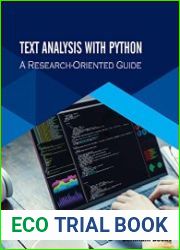



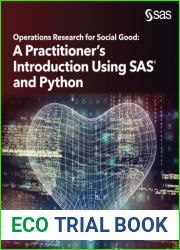
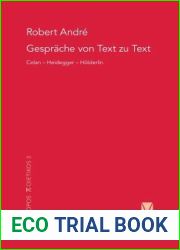

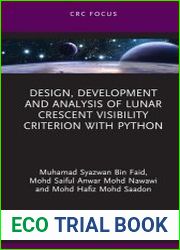

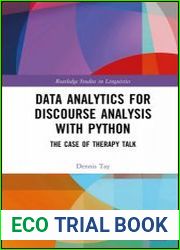
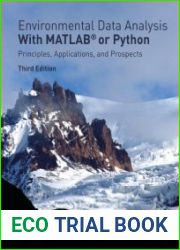
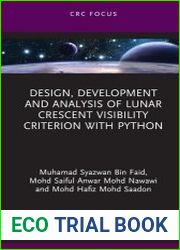


![Language, Text, and Knowledge: Mental Models of Expert Communication (Text, Translation, Computational Processing [TTCP], 2) Language, Text, and Knowledge: Mental Models of Expert Communication (Text, Translation, Computational Processing [TTCP], 2)](https://myecobook.life/img/5/509784_oc.jpg)
